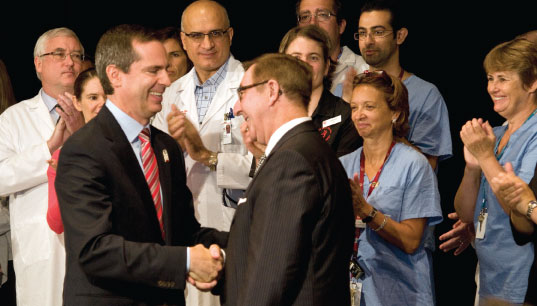
It takes time and nurturing to grow a top-flight hospital. The University of Ottawa Heart Institute, which began largely as an extension of the Ottawa Civic Hospital when its doors first opened in 1976, has matured to become Canada’s foremost cardiovascular centre. Superior expertise in surgical procedures, diagnostics, teaching and research has produced a world-class resource that is saving lives and changing medical practice in Ontario, across Canada and beyond.
But as clinical programs and services, patient loads and the research enterprise have all steadily expanded, the Heart Institute has outstripped the capacity of its current facilities.
The master plan envisions a five-storey building tucked between the area now reserved for shipping/receiving and the Regional Cancer Centre at The Ottawa Hospital side of the campus. The extension plus a sub-level would extend and modernize current facilities, creating an entirely new area for cardiac surgery, catheterizations and electrophysiology. These critical procedures are currently carried out in the basement, the oldest part of the Heart Institute building.
Plans and proposals that have been in the works for years came to the fore in late August, with a news conference at the Heart Institute announcing the Ontario government’s commitment to fund a building extension and major renovation.

“This is a great day for the Heart Institute, and we owe a debt of thanks to the many people who have made this possible,” said Dr. Robert Roberts, CEO and President.
Currently, the Heart Institute sees up to 80,000 patients a year, some of whom travel from across the country including Baffin Island, for diagnosis and treatment, including heart transplantation.
Much more work lies ahead before the first shovel breaks ground. The completion date is estimated anywhere between 2015 and 2017. Detailed design plans will first be commissioned for what will become a $200-million extension to be situated at the southwest side of the existing building.
The master plan and program for renovation and expansion were submitted to the Ontario Ministry of Health in 2007. Details of the plan underscored the state of care and services at the Heart Institute and projections of future cardiac care needs as far as 2031. Changing demographics in the form of an aging population and a growing number of elderly old (age 85 and beyond), together with the increased care required by patients’ concomitant conditions, made it apparent that the Heart Institute was not suitably equipped for future demands for services.
Initial plans for the extension and renovations called for about 169,000 sq. ft. of space. Those plans have been revised several times, owing to continual growth in several Heart Institute programs, including cardiac imaging and electrophysiology treatment, which have expanded to allow for a new Pacemaker Clinic.
The Heart Institute now has two electrophysiology (EP) labs and eight electrophysiologists, who are concerned with heart rhythm. Part of the electrophysiology group was involved with one of the largest, most prominent studies in the world related to the use of pacemakers and implanted defibrillators in patients with heart failure. Their research continues with the renewal of a substantial grant of nearly $5 million over the next five years from the Canadian Institutes of Health Research.
By 2009, a revised expansion plan called for 185,540 sq. ft., including a third EP lab, and the initial $147-million price tag had climbed to $170 million. Since then, research-related cardiac imaging expanded, particularly in the aftermath of a world-wide shortage in medical isotopes, owing to the shutdown of a nuclear reactor at Chalk River, Ontario.
New funding for the Heart Institute to research and develop alternative isotopes, along with a growing suite of imaging equipment, substantially increased space requirements. In late 2009, the Heart Institute acquired advanced scanning technology through single photon emission computer to-mography (SPECT) imaging—a particular method that allows physicians to tailor radiation exposure for individual patients.
The latest projection for construction and equipment calls for an estimated $198 million in funds. A quick list of details for the extension are highlighted above with an aerial view of where the proposed extension will be physically located.
The neighbourhood will undergo a change, but as Yasir Naqvi, MPP for Ottawa Centre, told an audience of about 400 staff, guests and government officials during the news conference to announce the commitment: “We are grateful to have you as neighbours. The Heart Institute is a world-renowned treatment facility that is the envy of hospitals around the world. Right here, our doctors and researchers have made important discoveries and blazed a trail in cardiovascular care.”


